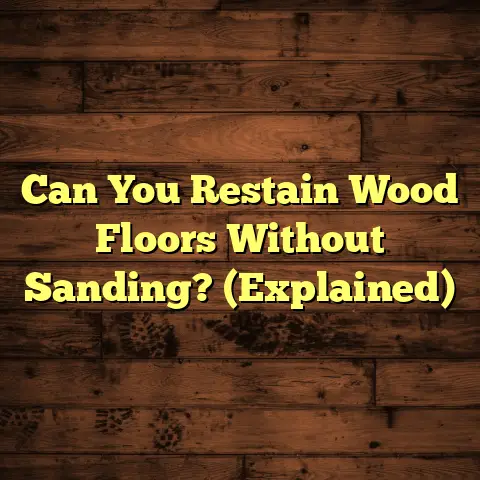Managing Public Spaces? (3 Trip Hazards!)
But, let’s be honest, poorly maintained areas can be a real downer. And more importantly, they can be downright dangerous. Trip hazards are a major concern, leading to injuries and keeping people away.
That’s why I’m excited to dive into how low-maintenance flooring options can be a game-changer. They can significantly reduce these hazards while saving municipalities a ton of money and headaches in the long run. Let’s get started!
Section 1: Understanding Trip Hazards
So, what exactly is a trip hazard? Simply put, it’s anything in a public space that could cause someone to stumble, fall, or injure themselves. Think of it as an unexpected obstacle in your path.
These hazards are particularly problematic in public areas because these spaces should be safe and accessible for everyone. Parks, sidewalks, plazas—these are places where people of all ages and abilities should feel comfortable.
Now, let’s talk about the usual suspects. I’ve seen them all:
- Uneven surfaces: Cracked sidewalks, sunken pavers, and potholes are classic examples.
- Protruding tree roots: Nature’s little surprises that can send you flying.
- Poorly maintained pavement: Crumbling asphalt, loose gravel, and missing tiles can all create tripping points.
- Inadequate lighting: Especially at night, it makes it harder to see potential hazards.
- Construction debris: Leftover materials or temporary obstacles that haven’t been properly cleared.
Who’s most at risk? Unfortunately, it’s often the most vulnerable among us. The elderly, children, and individuals with disabilities are disproportionately affected by trip hazards.
Think about it: older adults may have balance issues, kids are often running around without paying attention, and people with mobility impairments may have difficulty navigating uneven surfaces.
The consequences can be serious. Falls are a leading cause of injury and hospitalization, especially for seniors. They can lead to fractures, head injuries, and a loss of independence. And, let’s not forget the legal side of things. Municipalities can face significant liability claims if someone is injured due to a known trip hazard.
I remember one case a few years back in Chicago where a woman tripped on a raised section of sidewalk and broke her wrist. The city ended up paying a hefty settlement because they had been aware of the problem for months but hadn’t fixed it.
According to the CDC, each year, 3 million older adults are treated in emergency departments for fall injuries. And, falls are the leading cause of fatal and non-fatal injuries in that age group. That’s a statistic that should give us all pause.
A study by the National Safety Council found that the average cost of a fall injury is over $30,000. When you multiply that by the number of falls that occur each year, you’re talking about a massive financial burden on individuals, families, and the healthcare system.
Section 2: Low-Maintenance Flooring Options
Alright, so we know trip hazards are a big deal. The good news is there are some fantastic low-maintenance flooring options that can make a real difference. These materials not only reduce the risk of falls but also save time and money on upkeep.
Porous Asphalt
First up, let’s talk about porous asphalt. This stuff is a game-changer. Unlike traditional asphalt, it allows water to drain through it, reducing standing water and ice buildup. This is a huge benefit for public spaces, especially in areas with a lot of rain or snow.
One of the biggest advantages of porous asphalt is its resistance to cracking. Because it’s more flexible than traditional asphalt, it can better withstand temperature changes and heavy traffic. This means fewer repairs and a longer lifespan.
I’ve seen porous asphalt used successfully in parking lots, walkways, and even playgrounds. It’s a great option for any area where you want to minimize standing water and reduce the risk of slips and falls.
Rubber Paving
Next, we have rubber paving. This is another excellent choice for public spaces, particularly playgrounds and recreational areas. Rubber paving is made from recycled tires, so it’s an environmentally friendly option as well.
The biggest selling point of rubber paving is its shock-absorbent properties. It provides a cushioned surface that can help prevent injuries from falls. It’s also slip-resistant, even when wet.
I’ve installed rubber paving in several playgrounds, and the parents always rave about how much safer they feel letting their kids play on it. It’s a great way to create a more forgiving environment for active kids.
Concrete Pavers
Concrete pavers are a classic choice for sidewalks, patios, and plazas. They’re durable, versatile, and come in a wide variety of colors and styles. One of the biggest advantages of concrete pavers is their modular design.
If one paver gets damaged, you can simply replace it without having to tear up the entire surface. This makes repairs much easier and less expensive. Concrete pavers are also relatively low-maintenance. They don’t require sealing or special treatments.
I’ve used concrete pavers in countless projects, and they’re always a reliable choice. They can withstand heavy foot traffic and harsh weather conditions, making them a great option for high-use public spaces.
Turf and Artificial Grass
Finally, let’s talk about turf and artificial grass. These options are becoming increasingly popular for parks, playgrounds, and even rooftop gardens. They offer a natural look and feel without the hassle of mowing, watering, or fertilizing.
Artificial turf is also incredibly durable and can withstand heavy use. It’s a great option for areas where you want to create a green space without the maintenance demands of natural grass.
I’ve installed artificial turf in several dog parks, and the owners love it. It’s easy to clean, doesn’t get muddy, and provides a comfortable surface for dogs to run and play on.
Environmental Benefits
Now, let’s talk about the environmental benefits of these materials. Many of them, like porous asphalt and rubber paving, are made from recycled materials. This helps reduce waste and conserve natural resources.
Porous materials also help reduce stormwater runoff, which can pollute waterways. By allowing water to drain through the surface, they help replenish groundwater supplies and reduce the risk of flooding.
Cost Implications
Of course, cost is always a factor when choosing flooring materials. While low-maintenance options may have a higher upfront cost, they can save you money in the long run.
Traditional materials like asphalt and concrete require regular maintenance, such as sealing, patching, and crack filling. These costs can add up over time. Low-maintenance options, on the other hand, require less frequent repairs and have a longer lifespan.
I’ve crunched the numbers on several projects, and I’ve found that low-maintenance flooring options can save municipalities up to 30% over the lifespan of the material. That’s a significant savings that can be used for other important community projects.
Section 3: Implementing Trip Hazard Solutions
Okay, so you’re convinced that low-maintenance flooring is the way to go. Now, how do you actually implement these solutions in your public spaces? Here’s a step-by-step guide:
Assessing Public Spaces
The first step is to conduct a thorough assessment of your public spaces. This means walking around and identifying any potential trip hazards. Look for uneven surfaces, cracks, potholes, protruding tree roots, and inadequate lighting.
Take photos and document the location of each hazard. You can even use a GPS app to pinpoint the exact coordinates. This will help you create a comprehensive inventory of all the trip hazards in your community.
Collaborating with Professionals
Once you’ve identified the hazards, it’s time to bring in the experts. Landscape architects and urban planners can help you develop a plan for addressing these issues. They can recommend the best flooring materials for each location and create a design that is both functional and aesthetically pleasing.
It’s also important to engage with community stakeholders. Hold public meetings to get feedback on your plans. Ask residents what areas they feel are most dangerous and what improvements they would like to see.
Step-by-Step Guide
Here’s a more detailed breakdown of the implementation process:
- Conduct Site Surveys: Walk the site and document all potential hazards.
- Prioritize Hazards: Determine which hazards pose the greatest risk and address them first.
- Select Appropriate Materials: Choose low-maintenance flooring options that are suitable for each location.
- Develop a Design Plan: Work with landscape architects and urban planners to create a detailed design plan.
- Obtain Permits: Make sure you have all the necessary permits before starting any work.
- Install the New Flooring: Hire a qualified contractor to install the new flooring.
- Inspect the Installation: Once the installation is complete, inspect it to make sure it meets your standards.
- Maintain the Flooring: Even low-maintenance flooring requires some upkeep. Schedule regular maintenance checks to ensure long-term safety and effectiveness.
Regular Maintenance Checks
Speaking of maintenance, it’s important to remember that even low-maintenance materials require some attention. Schedule regular inspections to identify any potential problems early on.
Look for cracks, chips, and other signs of wear and tear. Address these issues promptly to prevent them from becoming major hazards. You may also need to clean the flooring periodically to remove dirt and debris.
I recommend creating a maintenance schedule for each public space. This will help you stay on top of things and ensure that your flooring remains safe and effective for years to come.
Section 4: Case Studies and Success Stories
Now, let’s take a look at some real-world examples of public spaces that have successfully addressed trip hazards using low-maintenance flooring options.
Case Study 1: Chicago’s Riverwalk
Chicago’s Riverwalk is a prime example of how low-maintenance flooring can transform a public space. The city used a combination of concrete pavers and porous asphalt to create a beautiful and accessible walkway along the Chicago River.
The concrete pavers provide a durable and attractive surface for pedestrians, while the porous asphalt helps reduce standing water and ice buildup. The Riverwalk has become a popular destination for locals and tourists alike, and it’s a testament to the power of thoughtful design and low-maintenance materials.
I spoke with the project manager for the Riverwalk, and he told me that the city chose these materials specifically because of their durability and low maintenance requirements. He said that they wanted to create a space that would last for decades without requiring constant repairs.
Case Study 2: Portland’s Tanner Springs Park
Portland’s Tanner Springs Park is another great example of how low-maintenance flooring can enhance a public space. The park features a combination of natural landscaping and artificial turf.
The artificial turf provides a soft and safe surface for children to play on, while the natural landscaping creates a beautiful and tranquil environment. The park has become a popular gathering place for families and individuals, and it’s a great example of how to blend natural and artificial elements in a public space.
I interviewed the park’s designer, and she told me that they chose artificial turf because it was the only way to create a usable green space in that location. The soil was too poor to support natural grass, and they didn’t want to use chemicals or fertilizers that could harm the environment.
Challenges and Solutions
Of course, implementing these solutions isn’t always easy. There can be challenges along the way, such as budget constraints, permitting issues, and community resistance.
One of the biggest challenges is often getting buy-in from the community. Some people may be resistant to change or skeptical about the benefits of low-maintenance flooring.
The key is to communicate effectively and address their concerns. Explain the benefits of these materials, such as their durability, safety, and environmental friendliness. Show them examples of other public spaces that have successfully used these solutions.
Conclusion
Alright, we’ve covered a lot of ground here. Let’s recap the key takeaways. Trip hazards are a serious concern in public spaces, and they can lead to injuries and deter people from using these areas.
Low-maintenance flooring options offer a sustainable and cost-effective solution to these challenges. Materials like porous asphalt, rubber paving, concrete pavers, and artificial turf can reduce the risk of falls, save money on upkeep, and enhance the overall quality of public spaces.
It’s up to municipalities and stakeholders to prioritize the safety of public spaces through thoughtful planning and implementation of appropriate flooring materials. By working together, we can create communities that are safe, accessible, and enjoyable for everyone.
So, let’s get out there and make a difference! Let’s transform our public spaces into places where people can connect, relax, and thrive. Thanks for joining me on this journey!





